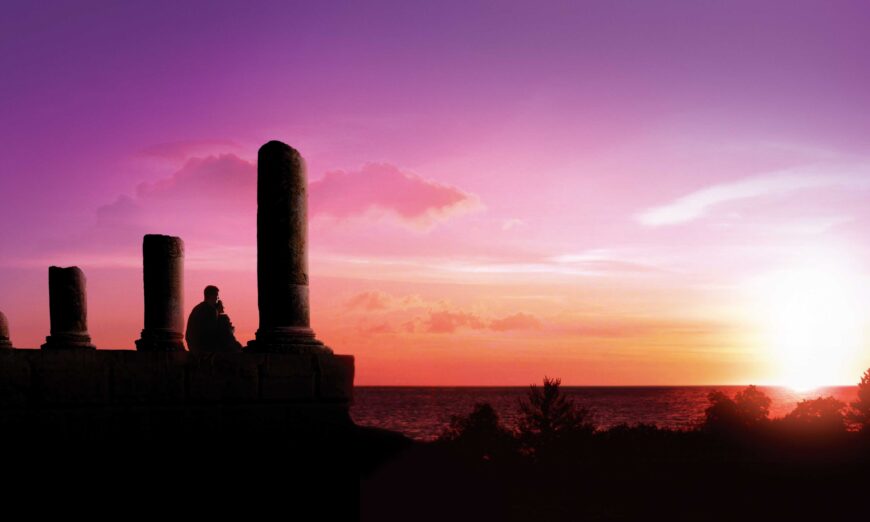Tunisia has always been marked by the different civilizations that have succeeded one another on its territory. It is a country distinguished by its rich historical and authentic cultural heritage.
Tunisia has nine sites on the list, eight of which are listed for their cultural significance and one, the Ichkeul National Park, for natural significance. This site was listed endangered between 1996 and 2006 because of construction of dams that threatened the hydrological regime of the lake and resulted in reduction of vegetation and drop in bird numbers. By 2006 the situation has improved so the site was removed from the endangered list. The first three sites were listed in 1979 and the most recent, Djerba, in 2023. In addition, Tunisia has 15 sites on the tentative list. The country has served on the World Heritage Committee four times.
Cultural:
- Amphitheatre of El Jem (1979); 2. Archaeological Site of Carthage (1979); 3. Djerba: Testimony to a settlement pattern in an island territory (2023); 4. Dougga / Thugga (1997); 5. Kairouan (1988); 6. Medina of Sousse (1988); 7. Medina of Tunis (1979); 8. Punic Town of Kerkuane and its Necropolis (1985, 1986)
Natural:
- Ichkeul National Parka
Amphitheatre of El Jem
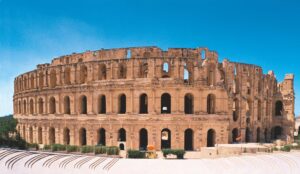
The impressive ruins of the largest colosseum in North Africa, a huge amphitheatre which could hold up to 35,000 spectators, are found in the small village of El Jem. This 3rd-century monument illustrates the grandeur and extent of Imperial Rome.
Archaeological Site of Carthage
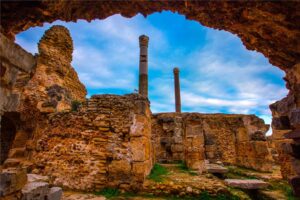
Carthage was founded in the 9th century B.C. on the Gulf of Tunis. From the 6th century onwards, it developed into a great trading empire covering much of the Mediterranean and was home to a brilliant civilization. In the course of the long Punic wars, Carthage occupied territories belonging to Rome, which finally destroyed its rival in 146 B.C. A second – Roman – Carthage was then established on the ruins of the first.
Djerba: Testimony to a settlement pattern in an island territory
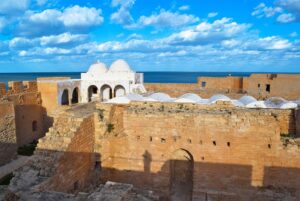
This serial property is a testimony to a settlement pattern that developed on the island of Djerba around the 9th century CE amidst the semi-dry and water-scarce environment. Low‑density was its key characteristic: it involved the division of the island into neighbourhoods, clustered together, that were economically self-sustainable, connected to each other and to the religious and trading places of the island, through a complex network of roads. Resulting from a mixture of environmental, socio-cultural and economic factors, the distinctive human settlement of Djerba demonstrates the way local people adapted their lifestyle to the conditions of their water-scarce natural environment.
Dougga / Thugga

Before the Roman annexation of Numidia, the town of Thugga, built on an elevated site overlooking a fertile plain, was the capital of an important Libyco-Punic state. It flourished under Roman and Byzantine rule, but declined in the Islamic period. The impressive ruins that are visible today give some idea of the resources of a small Roman town on the fringes of the empire.
Kairouan
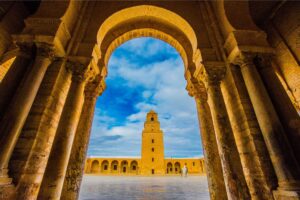
Founded in 670, Kairouan flourished under the Aghlabid dynasty in the 9th century. Despite the transfer of the political capital to Tunis in the 12th century, Kairouan remained the Maghreb’s principal holy city. Its rich architectural heritage includes the Great Mosque, with its marble and porphyry columns, and the 9th-century Mosque of the Three Gates.
Medina of Sousse
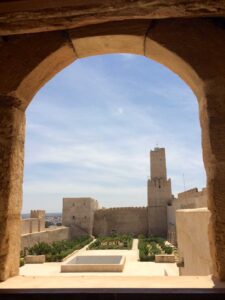
Sousse was an important commercial and military port during the Aghlabid period (800–909) and is a typical example of a town dating from the first centuries of Islam. With its kasbah, ramparts, medina (with the Great Mosque), Bu Ftata Mosque and typical ribat (both a fort and a religious building), Sousse was part of a coastal defence system.
Medina of Tunis
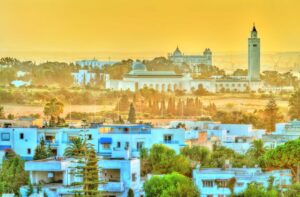
Under the Almohads and the Hafsids, from the 12th to the 16th century, Tunis was considered one of the greatest and wealthiest cities in the Islamic world. Some 700 monuments, including palaces, mosques, mausoleums, madrasas and fountains, testify to this remarkable past.
Punic Town of Kerkuane and its Necropolis
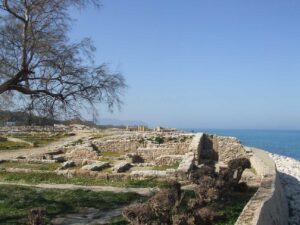
This Phoenician city was probably abandoned during the First Punic War (c. 250 B.C.) and as a result was not rebuilt by the Romans. The remains constitute the only example of a Phoenicio-Punic city to have survived. The houses were built to a standard plan in accordance with a sophisticated notion of town planning.

